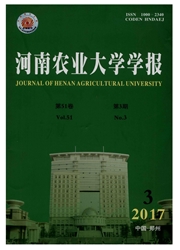

 中文摘要:
中文摘要:
采用烟碱转化株早期诱导鉴别方法,对3个白肋烟杂交种及其亲本的烟碱转化率进行了分析.结果表明,不同杂交种生物碱组成和含量存在显著差异,其中达白1号和达白2号烟碱转化问题相对较小,但群体中仍然存在不同程度转化株,总转化株比例分别为10.9%和23.7%,其中多为低转化株、达白3号问题比较突出,所测烟株全部为转化株,且转化程度较高,多为高转化株,平均烟碱转化率达至小38.3%.达白1号的2个亲本MSKY 14和达所26均存在一定比例的转化株,对达白1号群体中转化株的产生均有贡献.达白2号的母本MSVA 509多为非转化株,父本达所26对烟碱转化的贡献较大.达白3号父本达所27总转化株比例和高转化株比例都接近100%,是造成达白3号杂交种高烟碱转化株比例的主导因素.
 英文摘要:
英文摘要:
Early conversion stimulation and converter identification method was used to analyze the nicotine conversion rate of three burley hybrids and their parents. The results showed that the alkaloid composition and contents in tobacco leaves of different hybrids were significantly different. The problem of nicotine conversion in Dabai 1 and Dabai 2 was less serious, but there existed certain amount of converters, with the proportions of total converters of 10.9% and 23.7% , respectively, most of which being low converters. The problem of conversion in Dabai 3 was much more serious, with all the tested plants being converters and the majority being high converters; the average conversion rate was 38.3%. The two parents of Dabai 1 , MSKY 14 and Dasuo 26 both had certain amount of converters in the populations and therefore contributed to the conversion level in the hybrid. The male parent of Dabai 2, Dasuo 26, was the main contributor of conversion gene to the hybrid. The male parent of Dabai 3, Dasuo 27, had extremely high converter proportion and conversion level, and was the exclusive contributor of conversion gene to Dabai 3 which had high nicotine conversion level.
 同期刊论文项目
同期刊论文项目
 同项目期刊论文
同项目期刊论文
 期刊信息
期刊信息
